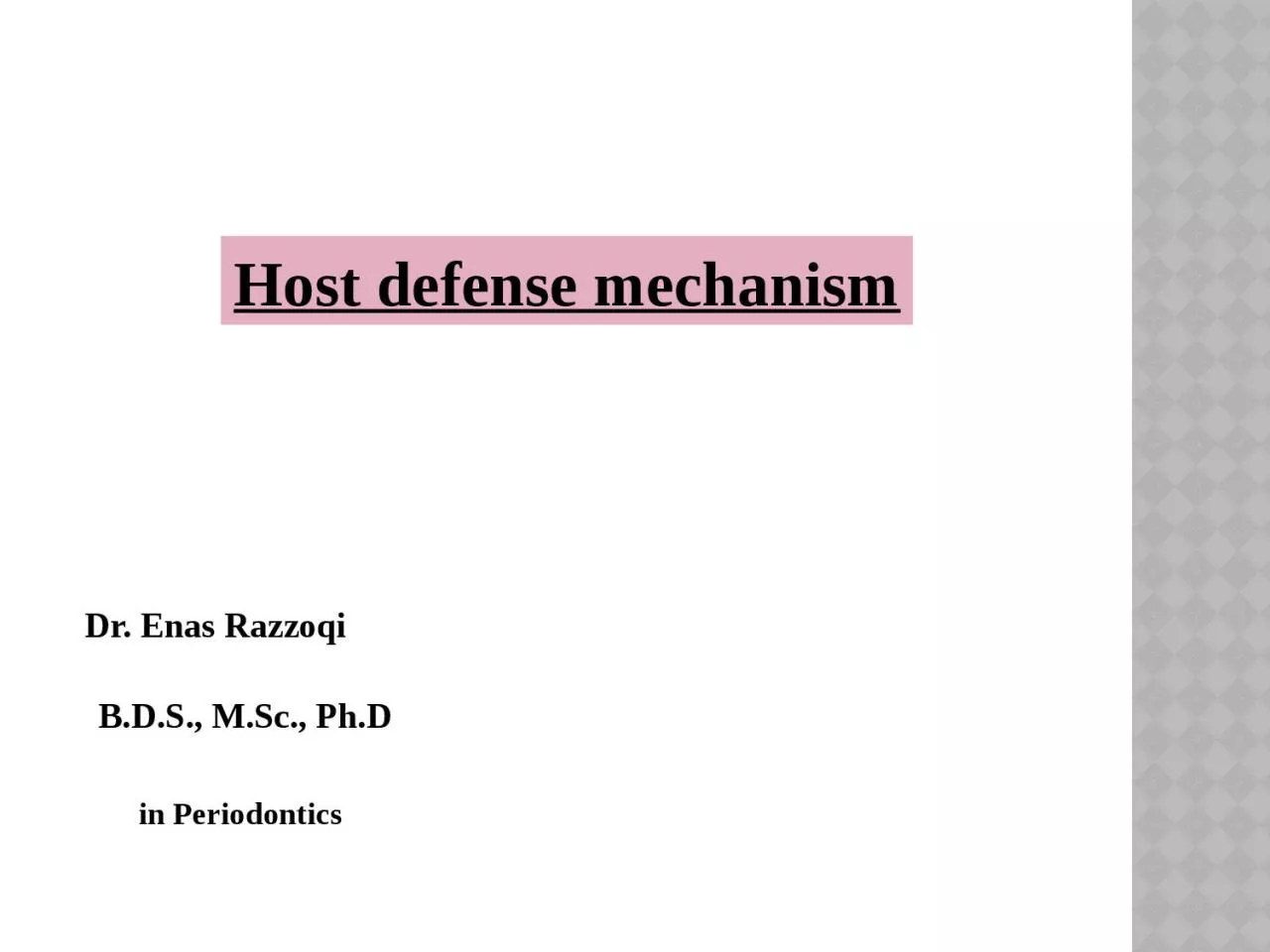

Enas Razzoqi BDS MSc PhD in Periodontics Most important cytokines are Cytokines are group of small soluble proteins or glycoproteins secreted by different cells in the body usually in response to stimulation which act as messenger molecules transmitting signals to othe ID: 933802
Download Presentation The PPT/PDF document "Host defense mechanism Dr." is the property of its rightful owner. Permission is granted to download and print the materials on this web site for personal, non-commercial use only, and to display it on your personal computer provided you do not modify the materials and that you retain all copyright notices contained in the materials. By downloading content from our website, you accept the terms of this agreement.
Slide1
Host defense mechanism
Dr. Enas Razzoqi
B.D.S., M.Sc., Ph.D
in
Periodontics
Slide2Most important cytokines are
Cytokines are group of small soluble proteins or
glycoproteins
secreted by different cells in the body, usually in response to stimulation which act as messenger molecules transmitting signals to other cells and induced responses through binding to specific receptors to control and coordinate cellular behavior and function
The complex interaction among lymphocytes, inflammatory cells, and other cellular elements in connective tissue are mediated by a series of low- molecular weight proteins called
(cytokines).
Slide3stimulation of the production of endothelial adhesion molecules to begin the inflammatory process.
Activation of phagocytosis.
Production of prostaglandins by fibroblasts and
osteoclasts
.
IL-1
Tumor necrosis factors (TNFs) (α and β):
are produced by macrophages and T-cells, cause necrosis of certain tumors. They also cause activation of
osteoclast
to induce bone
resorption
, and they aid leukocyte in their ability to adhere to endothelial cells and increases their phagocytosis and
chemotaxis
.
Slide4IL-2
the growth, proliferation, and differentiation of T cells to become 'effector
' T cells.IL-4
activation , division
and the differentiation of
B cells
into plasma cell. growth factor of mast cells.
Slide5IL-8
IL-6
stimulates mast cells.
is
chemotactic
for
neutrophils and increases their adherence to endothelial cells.
One of the major functions of IL-6 is the induction of the final maturation of
B-cells into immunoglobulin-secreting
plasma cells. It stimulates the secretion of antibodies
macrophages and T-cells
macrophges
Slide6associated with antiviral activity and enhance phagocytosis, and causes bone
resorption.
T-cells
Interferons
Migration inhibitory factor (MIF):
inhibit the migration of macrophages from an area of inflammation, so that increasing the population of macrophages in that area.
Lymphotoxin
(LT):
is produced by activated T-cells. It activates leukocytes and it is cytotoxic
to gingival fibroblasts.
Slide7Matrix metalloproteinase (MMPs):
are group of enzymes that degrade collagen, the ground substance. The most important one is the (PMN) collagenase.
Slide8H
umoral immune response:-
Activation of B lymphocytes
produce antibodies especially
IgG
and
IgA
protective role in the pathogenesis of
P.d.diseases
Controlled by type 2 T-helper cells (TH2).
Slide9Slide101. Plaque antigens
leave the gingiva in the lymphatics
Antigen-presenting cells
reach the lymph node
Stimulate lymphocytes
antibodies are produced by plasma cells
Antibodies travel back to the
gingiva
via blood vessels
Antibodies leave the circulation and are carried
to the crevice
Antibody action on microbes in the crevice
Slide11Initiated when antigen which is from subgingival
plaque stimulates T lymphocytes to produce
lymphokines
(cytokines).
Cellular immune response:
cell mediated immune response
Regulated by type 1 T-helper cells (
TH1)
Slide12Slide131. Plaque antigens
leave the gingiva in the lymphatics
Antigen-presenting cells
reach the lymph node
Stimulate lymphocytes
B and T cells proliferate
enter the blood stream
lymphocytes "home" back to the
periodontium
Antibodies are produced locally by plasma cells
Slide14Antigen
(any substance that elicits a specific immune response)